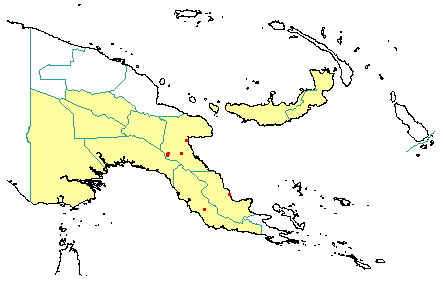
in PNGplants database
PNGTreesKey – Adinandra forbesii Baker f. |
Barry Conn (NSW) & Kipiro Damas (LAE).
Guide to trees of Papua New Guinea
Copyright held by the authors, National Herbarium of New South Wales, and Papua New Guinea National Herbarium
Journal of Botany Vol. 61, Supplement 4: (1923)
Family: Pentaphylaceae
Dicotyledon
Timber Group: Occasional timber species
Field Characters: Large canopy tree (10-40 m high) or Small sub-canopy tree; Bole cylindrical (20-35 cm diam., rarely to 64 cm); straight (bole 8-25 m long); buttresses buttresses absent; spines spines absent; aerial roots aerial roots absent; stilt roots stilt roots absent; Bark brownish grey or dark brown, slightly rough or smooth, scattered pustular, lenticels rounded/swelling; Subrhytidome (under-bark) red or brown; less than 25 mm thick, 20.0; bark blaze consisting of one layer; strongly aromatic; pleasant; outer blaze pale yellow or pink, with stripes (orange-coloured), fibrous; inner blaze pale yellow or pink, with stripes (orange-coloured), fibrous; bark exudate (sap) present, colourless, not readily flowing (spotty), slightly colour changing on exposure to air, to pale grey, not sticky; terminal buds not enclosed by leaves.
Indumentum: Complex hairs absent; stinging hairs absent; mature twig indumentum (hairs) absent.
Leaves: Leaves spaced along branches, spiral (leaves occurring singly at a node and arranged spirally up the branchlet), simple (a leaf composed of a single blade); petiole present, not winged, attached to base of leaf blade, not swollen; leaves broadest at or near middle, 7.0-10.0 cm, 4.0-5.5 cm; symmetric, entire, not dissected or lobed, obtuse or sub acuminate, venation pinnate, secondary veins open, prominent, intramarginal veins absent; leaves lower surface pale green, upper surface dark green (glossy), indumentum (hairs) absent; absent; domatia absent; stipules absent.
Flowers: Inflorescence axillary or on the trunk or branches (by misinterpretation below leaves), flowers on an unbranched axis, cones absent; flowers bisexual, stalked, flowers with many planes of symmetry, 12.0-20.0 mm long, diameter large (more than10 mm diam.) (15-25 mm diameter); perianth present, with distinct sepals and petals whorls, inner perianth white, red (dark sometimes), or cream-coloured (with pink-purple to deep red tinge, especially near margin); 5, free; stamens 100, present, joined, free of the perianth; ovary superior, carpels joined (when more than one), locules 5; styles solitary, 1 (base persistent in fruit).
Fruits: Infrutescence arranged on unbranched axis, fruit 20.0-25.0 mm long, 15.0-20.0 mm diam., green (dark when immature), not spiny, fleshy, simple, indehiscent, drupe; seeds 5, not winged, narrow (longer than wide).
Distribution: Morobe, Western Highlands, Eastern Highlands, Southern Highlands, Western, Gulf, Central, Northern & New Britain.
 | Botanical records in PNGplants database |
Notes: Notes Adinandra was previously classified in the family Theaceae.